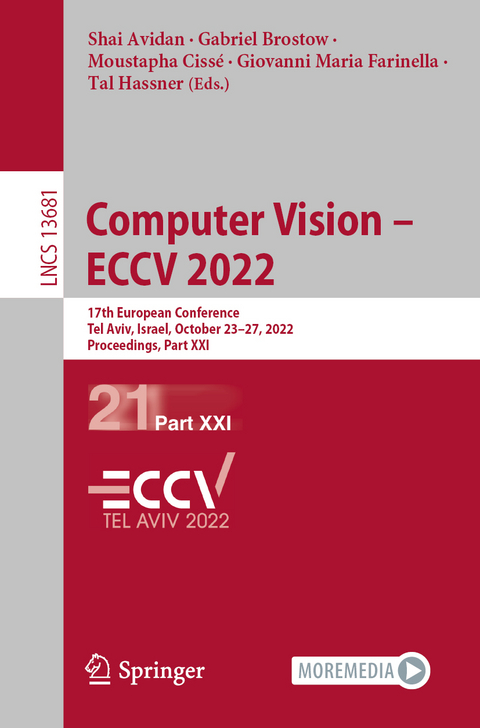
Computer Vision – ECCV 2022
Springer International Publishing (Verlag)
978-3-031-19802-1 (ISBN)
The 39-volume set, comprising the LNCS books 13661 until 13699, constitutes the refereed proceedings of the 17th European Conference on Computer Vision, ECCV 2022, held in Tel Aviv, Israel, during October 23-27, 2022.
The 1645 papers presented in these proceedings were carefully reviewed and selected from a total of 5804 submissions. The papers deal with topics such as computer vision; machine learning; deep neural networks; reinforcement learning; object recognition; image classification; image processing; object detection; semantic segmentation; human pose estimation; 3d reconstruction; stereo vision; computational photography; neural networks; image coding; image reconstruction; object recognition; motion estimation.
Active Label Correction Using Robust Parameter Update and Entropy Propagation.- Unpaired Image Translation via Vector Symbolic Architectures.- UniNet: Unified Architecture Search with Convolution, Transformer, and MLP.- AMixer: Adaptive Weight Mixing for Self-Attention Free Vision Transformers.- TinyViT: Fast Pretraining Distillation for Small Vision Transformers.- Equivariant Hypergraph Neural Networks.- ScaleNet: Searching for the Model to Scale.- Complementing Brightness Constancy with Deep Networks for Optical Flow Prediction.- ViTAS: Vision Transformer Architecture Search.- LidarNAS: Unifying and Searching Neural Architectures for 3D Point Clouds.- Uncertainty-DTW for Time Series and Sequences.- Black-Box Few-Shot Knowledge Distillation.- Revisiting Batch Norm Initialization.- SSBNet: Improving Visual Recognition Efficiency by Adaptive Sampling.- Filter Pruning via Feature Discrimination in Deep Neural Networks.- LA3: Efficient Label-Aware AutoAugment.- Interpretations Steered Network Pruning via Amortized Inferred Saliency Maps.- BA-Net: Bridge Attention for Deep Convolutional Neural Networks.- SAU: Smooth Activation Function Using Convolution with Approximate Identities.- Multi-Exit Semantic Segmentation Networks.- Almost-Orthogonal Layers for Efficient General-Purpose Lipschitz Networks.- PointScatter: Point Set Representation for Tubular Structure Extraction.- Check and Link: Pairwise Lesion Correspondence Guides Mammogram Mass Detection.- Graph-Constrained Contrastive Regularization for Semi-Weakly Volumetric Segmentation.- Generalizable Medical Image Segmentation via Random Amplitude Mixup and Domain-Specific Image Restoration.- Auto-FedRL: Federated Hyperparameter Optimization for Multi-Institutional Medical Image Segmentation.- Personalizing Federated Medical Image Segmentation via Local Calibration.- One-Shot Medical Landmark Localization by Edge-Guided Transform and Noisy Landmark Refinement.- Ultra-High-Resolution Unpaired Stain Transformation via Kernelized Instance Normalization.- Med-DANet: Dynamic Architecture Network for Efficient Medical Volumetric Segmentation.- ConCL: Concept Contrastive Learning for Dense Prediction Pre-training in Pathology Images.- CryoAI: Amortized Inference of Poses for Ab Initio Reconstruction of 3D Molecular Volumes from Real Cryo-EM Images.- UniMiSS: Universal Medical Self-Supervised Learning via Breaking Dimensionality Barrier.- DLME: Deep Local-Flatness Manifold Embedding.- Semi-Supervised Keypoint Detector and Descriptor for Retinal Image Matching.- Graph Neural Network for Cell Tracking in Microscopy Videos.- CXR Segmentation by AdaIN-Based Domain Adaptation and Knowledge Distillation.- Accurate Detection of Proteins in Cryo-Electron Tomograms from Sparse Labels.- K-SALSA: K-Anonymous Synthetic Averaging of Retinal Images via Local Style Alignment.- RadioTransformer: A Cascaded Global-Focal Transformer for Visual Attention-Guided Disease Classification.- Differentiable Zooming for Multiple Instance Learning on Whole-Slide Images.- Learning Uncoupled-Modulation CVAE for 3D Action-Conditioned Human Motion Synthesis.- Towards Grand Unification of Object Tracking.
| Erscheinungsdatum | 25.10.2022 |
|---|---|
| Reihe/Serie | Lecture Notes in Computer Science |
| Zusatzinfo | LVII, 755 p. 199 illus., 190 illus. in color. |
| Verlagsort | Cham |
| Sprache | englisch |
| Maße | 155 x 235 mm |
| Gewicht | 1211 g |
| Themenwelt | Informatik ► Grafik / Design ► Digitale Bildverarbeitung |
| Informatik ► Theorie / Studium ► Künstliche Intelligenz / Robotik | |
| Schlagworte | Applications • Computer Science • conference proceedings • Informatics • Research |
| ISBN-10 | 3-031-19802-6 / 3031198026 |
| ISBN-13 | 978-3-031-19802-1 / 9783031198021 |
| Zustand | Neuware |
| Haben Sie eine Frage zum Produkt? |
aus dem Bereich


